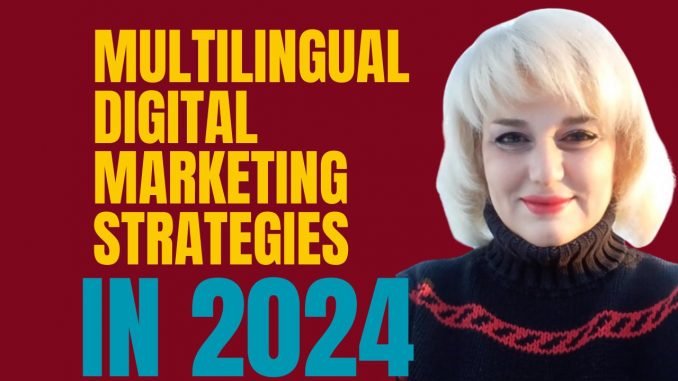
Multilingual Digital Marketing Strategies in 2024 Multilingual Digital Marketing Strategies in 2024 Before delving into multilingual digital marketing strategies in 2024 , thorough research is crucial to understand the target audience’s language preferences, cultural nuances, and online behaviors. Consider factors such as local customs, traditions, and societal norms, as these elements significantly impact the success of marketing efforts. The initial step in reaching a global audience is ensuring that your digital presence is accessible and appealing to users from different linguistic backgrounds. This involves accurately translating website content, adapting multimedia, and incorporating region-specific elements. Collaborating with native speakers or professional translation services is essential to maintain linguistic and cultural authenticity. Multilingual Digital Marketing Strategies in 2024 Optimizing your website for search engines in multiple languages is a critical aspect of a successful multilingual digital marketing strategy. Conduct keyword research in each target language to understand local users’ search habits. Tailor your content and meta tags to align with these keywords, enhancing your website’s visibility and search engine ranking in various regions. Social Media Engagement: Social media platforms are powerful tools for reaching a global audience. Create multilingual content that resonates with local audiences on region-specific platforms. Consider language-specific social media accounts and adapt your content strategy to align with cultural preferences and trends. Email Marketing: Segment your email lists based on language preferences to deliver personalized and relevant content. Craft engaging email campaigns that consider cultural sensitivities and local preferences. Utilize professional translation services to ensure accurate communication, avoiding misunderstandings that could harm your brand reputation. Paid Advertising: When running multilingual paid advertising campaigns, customize your ad copy and visuals to appeal to diverse audiences. Localize your message to reflect cultural nuances and preferences, ensuring that your ads resonate with potential customers. Utilize platforms that allow precise targeting to reach specific language-speaking demographics. Influencer Collaborations: Partnering with influencers from various regions can significantly boost your brand’s credibility and reach. Choose influencers who align with your brand values and have a genuine connection with their audience. Encourage influencers to create content in their native language to establish an authentic connection with their followers. User-generated Content (UGC): Encourage users from different regions to create content related to your products or services, including reviews, testimonials, and user-generated images. UGC adds authenticity to your brand and provides diverse perspectives, helping you connect with a wider audience. Localized Customer Support: Offer customer support in multiple languages to address inquiries and concerns effectively. Having a team of multilingual customer support representatives or using translation services ensures that customers from different regions feel supported and valued. Cultural Sensitivity Training: Train your marketing and customer support teams to be culturally sensitive, understanding cultural taboos, preferences, and communication styles to avoid unintentional misunderstandings. This cultural competence is crucial for building trust in diverse markets. Mobile Optimization: Many users in different regions access the internet primarily through mobile devices. Ensure that your website and digital content are optimized for mobile platforms to provide a seamless experience for users across the globe. Local Partnerships: Collaborate with local businesses, organizations, or influencers to strengthen your presence in specific regions. Local partnerships can provide insights into the market, increase brand visibility, and establish credibility among the target audience. Analytics and Monitoring : Implement analytics tools to track the performance of your multilingual campaigns. Regularly monitor website traffic, engagement metrics, and conversion rates across different language segments. Use these insights to refine your strategies and adapt to changing market dynamics. Adapt to Social Trends: Stay informed about cultural and social trends in different regions. Social media trends, in particular, can vary widely between countries. Adapting your content to align with these trends helps your brand stay relevant and resonate with local audiences. Legal and Regulatory Compliance: Be aware of and comply with legal and regulatory requirements in each target market, including privacy laws, advertising regulations, and other legal considerations. Failure to comply can lead to reputational damage and legal consequences. Continuous Feedback Loop: Establish a feedback loop with your international audience. Encourage users to provide feedback on your products, services, and marketing efforts. Use this feedback to make continuous improvements and demonstrate your commitment to meeting the needs of diverse customers. Regular Content Audits: Periodically review and update your multilingual content to ensure its accuracy, relevance, and alignment with cultural sensitivities. This includes updating product descriptions, blog posts, and any other content to reflect changes in language use or cultural expectations. By incorporating these additional strategies, businesses can create a comprehensive and adaptable multilingual digital marketing approach that resonates with diverse audiences, positioning the brand for sustained global success.

Leave a Reply